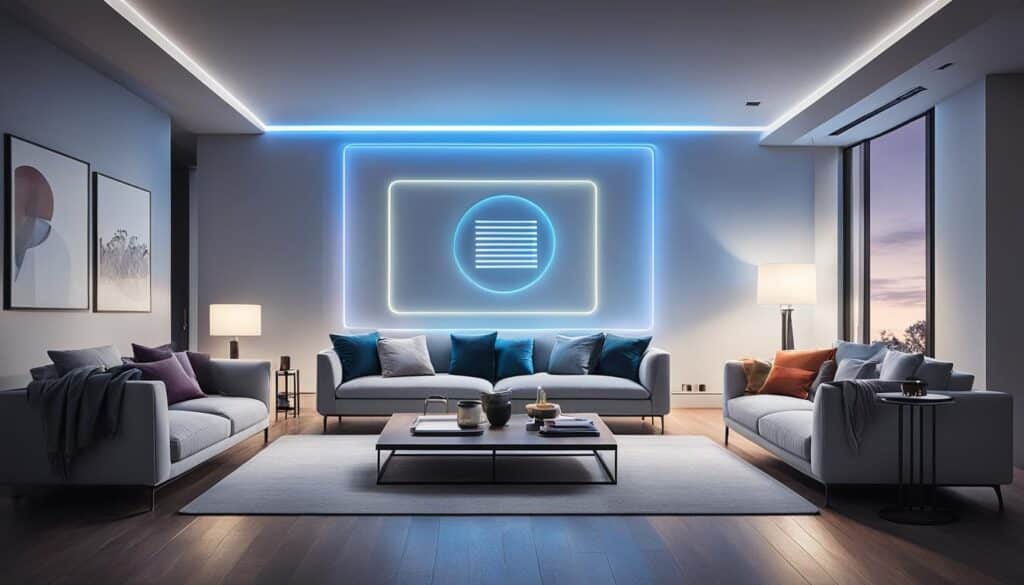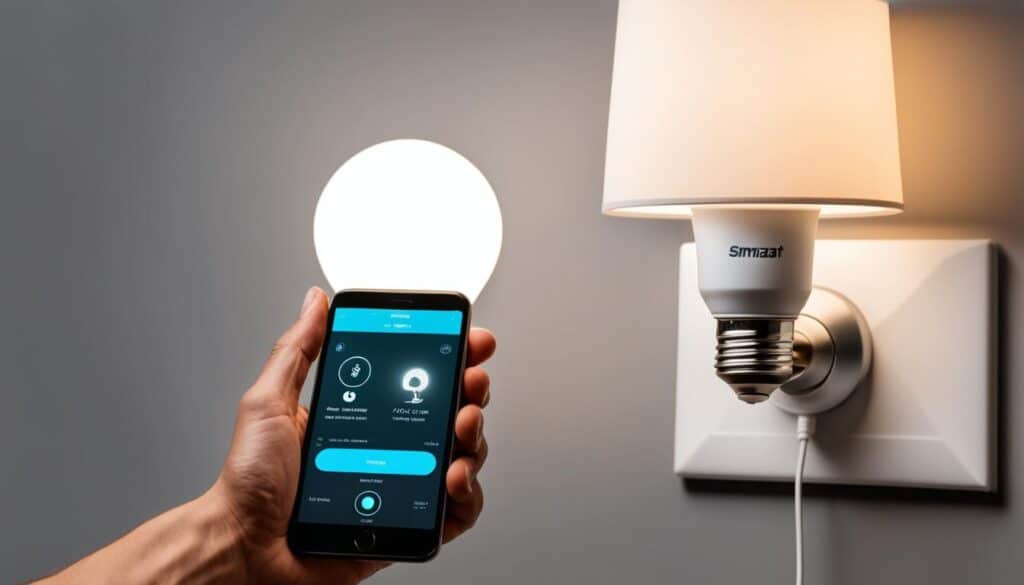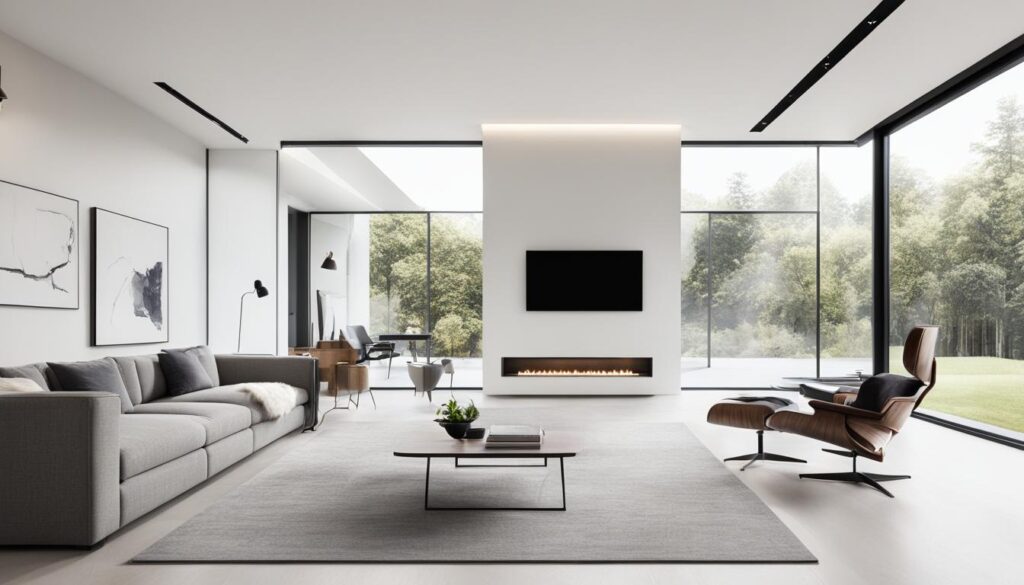Are you a beginner looking to dive into the world of smart home lighting controls? Don’t worry, I’ve got you covered! In this basic guide, I’ll walk you through everything you need to know about smart home lighting controls and how to set them up.
Smart home lighting controls are a game-changer when it comes to creating the perfect ambiance in your home. With just a few taps on your smartphone or a voice command, you can easily adjust the brightness, color, and even the schedule of your lights. Plus, with energy-saving features, you can save money on your electricity bills and reduce your carbon footprint.
But where do you start as a beginner? Don’t worry, it’s simpler than you might think. Whether you’re looking to create a cozy atmosphere for movie nights or set the perfect lighting for your home office, smart lighting controls have got you covered.
Table of Contents
Key Takeaways:
- Smart home lighting controls offer convenience and customization options for beginners.
- With smart lighting, you can easily adjust brightness, color, and schedule from your smartphone.
- Smart lighting controls are energy-saving, helping you reduce your carbon footprint.
- Setting up smart lighting controls is simpler than you might think.
- Start by researching different brands and models to choose the right system for your needs.
The Benefits of Smart Home Lighting Controls
Smart home lighting controls offer numerous benefits for users. By utilizing these advanced systems, you can enjoy a range of advantages that enhance your living environment and provide a more convenient and personalized lighting experience.
One of the key benefits of smart home lighting controls is the sheer convenience they offer. With a simple tap on your smartphone or a voice command to your smart speaker, you can easily control the lights in your home. No more getting up to turn off the lights or fumbling in the dark to find a switch. It’s all at your fingertips, making your life easier and more efficient.
Smart lighting controls also promote energy efficiency. Through features such as dimming functionality and scheduling options, you have precise control over the brightness and duration of your lights. This allows you to reduce energy consumption and lower your electricity bills. Additionally, smart lighting controls often integrate with motion sensors, ensuring that lights are only activated when needed, further optimizing energy usage.
With smart home lighting controls, you have the power to create customized lighting experiences tailor-made to suit your preferences and needs. Whether you want bright lighting for a productive work environment or soft, warm lighting to set a relaxing ambiance, smart lighting controls allow you to effortlessly adjust the brightness, color, and intensity of your lights. It’s like having a personal lighting designer right in your own home.
Not only do smart home lighting controls enhance convenience and energy efficiency, but they also have a positive impact on your overall comfort and mood. The ability to customize and adjust your lighting according to different activities and occasions can significantly enhance the atmosphere and ambiance of any space. Whether you’re hosting a party, enjoying a cozy movie night, or simply relaxing after a long day, smart lighting controls allow you to create the perfect lighting environment that complements your mood and enhances your well-being.
By harnessing the benefits of smart home lighting controls, you can transform your humble abode into a haven of convenience, energy efficiency, and personalized comfort.
Comparing the Benefits of Smart Home Lighting Controls
| Benefits | Description |
|---|---|
| Convenience | Control your lights with a tap on your smartphone or a voice command. |
| Energy Efficiency | Dimming functionality, scheduling options, and integration with motion sensors help reduce energy consumption. |
| Customization | Adjust the brightness, color, and intensity of your lights to create personalized lighting experiences. |
| Comfort and Mood Enhancement | Create the perfect lighting environment to suit different activities and occasions, enhancing overall comfort and mood. |
How to Choose the Right Smart Home Lighting Control System
When it comes to smart home lighting, choosing the right control system is crucial. The market offers a wide range of options, each with its own set of features and capabilities. To ensure you make an informed decision, consider the following factors:
- Compatibility: Before investing in a smart home lighting control system, check its compatibility with your existing devices and network. Ensure that it supports the type of bulbs or switches you plan to use, and that it can seamlessly integrate with other smart devices in your home.
- Ease of Use: A user-friendly interface and intuitive controls are essential for a pleasant lighting experience. Look for systems that offer easy setup and simple navigation, allowing you to effortlessly customize your lighting settings.
- Connectivity Options: Consider the connectivity options offered by the control system. Some systems use Wi-Fi, while others rely on Bluetooth or Zigbee. Assess your home’s network infrastructure and choose a system that aligns with your connectivity needs.
To make an informed decision, it’s important to research different brands and models, read customer reviews, and consider your specific requirements. By taking these steps, you can select a smart home lighting control system that seamlessly integrates into your lifestyle and enhances your home’s ambiance and functionality.
Comparison of Top Smart Home Lighting Control Systems
| Brand | Compatibility | Ease of Use | Connectivity Options |
|---|---|---|---|
| Philips Hue | Compatible with a wide range of smart devices | User-friendly app with intuitive controls | Wi-Fi and Zigbee |
| Lutron Caseta | Works with major smart home platforms | Simple installation and setup process | Clear Connect Wireless |
| TP-Link Kasa Smart | Compatible with popular voice assistants | Straightforward app interface | Wi-Fi |
| Nanoleaf | Supports various smart home ecosystems | Easy-to-use app with drag-and-drop controls | Wi-Fi and Thread |
Image:

Setting Up Smart Home Lighting Controls
Setting up smart home lighting controls is an exciting step towards creating a more efficient and personalized lighting experience. To help you get started, I’ll walk you through the process, from installing the necessary hardware to configuring the settings.
1. Install Smart Bulbs or Switches
The first step in setting up smart home lighting controls is to install the hardware. Depending on your preference, you can choose between smart bulbs or switches. Smart bulbs are a great option if you want to control each light individually, while smart switches allow you to control multiple lights simultaneously.
When installing smart bulbs, simply replace your existing bulbs with the smart ones. For smart switches, you’ll need to replace your traditional switches with the smart switches. If you’re not comfortable with DIY electrical work, it’s always a good idea to hire a professional electrician.
2. Connect to a Central Hub or Smartphone App
Once you’ve installed the hardware, the next step is to connect your smart home lighting controls to a central hub or a smartphone app. A central hub acts as a control center, allowing you to manage your lights from one central location. Alternatively, you can use a smartphone app that connects directly to your smart bulbs or switches.
To connect your lights to a central hub, follow the manufacturer’s instructions provided with the hub. This typically involves connecting the hub to your home Wi-Fi network and pairing it with your smart bulbs or switches. If you’re using a smartphone app, download the app associated with your specific smart lighting brand and follow the instructions to connect your lights.
3. Configure Settings and Personalize
Once you’ve connected your smart home lighting controls to a central hub or smartphone app, it’s time to configure the settings and personalize your lighting control according to your preferences. This includes setting timers, creating custom lighting scenes, adjusting brightness levels, and even exploring color options for RGB smart bulbs.
Take some time to familiarize yourself with the features and capabilities of your smart lighting system. Experiment with different settings to find the perfect lighting ambiance for different occasions. Whether it’s a cozy movie night or a bright and energizing workspace, smart lighting controls allow you to effortlessly customize the lighting in your home.

Exploring Different Smart Lighting Control Options
When it comes to smart lighting control, there is a wide range of options available to enhance your home’s lighting experience. Whether you prefer convenience, automation, or customization, there is a control method that will suit your needs and lifestyle. Let’s explore some of the popular smart lighting control options:
Voice Control
One of the most convenient ways to control your smart lights is through voice commands. With voice-controlled smart lighting systems like Amazon Alexa or Google Assistant, you can simply speak your desired commands, such as “Turn on the living room lights” or “Dim the bedroom lights to 50%”. Voice control eliminates the need for physical switches or smartphone apps, providing a hands-free and effortless lighting control experience.
Motion Sensors
Another popular option for smart lighting control is motion sensors. These sensors can detect movement in a room and automatically turn on the lights when someone enters the space. This feature is particularly useful in areas like hallways, bathrooms, or garages, where you may need immediate lighting without fumbling for switches. Motion sensors not only provide convenience but also contribute to energy efficiency by automatically turning off the lights when no motion is detected for a certain period.
Scheduling Features
If you prefer a set-and-forget approach to your lighting control, scheduling features are the way to go. With smart lighting systems that offer scheduling capabilities, you can create personalized lighting routines based on your daily activities or preferences. For example, you can schedule your porch lights to turn on automatically at sunset and turn off at sunrise, or program your bedroom lights to gradually dim as you wind down for the night. Scheduling features allow you to have the right lighting at the right time, making your home more comfortable and energy-efficient.
By exploring these different smart lighting control options, you can create a lighting system that complements your lifestyle and preferences. Whether you choose voice control, motion sensors, or scheduling features, smart lighting puts you in control of your home’s ambiance with just a few taps, words, or gestures.
| Control Option | Advantages |
|---|---|
| Voice Control |
|
| Motion Sensors |
|
| Scheduling Features |
|
Integrating Smart Home Lighting Controls with Other Devices
Smart home lighting controls can be integrated seamlessly with a variety of other smart devices, paving the way for a truly connected and convenient home environment. By integrating smart home lighting controls with other devices such as smart speakers, thermostats, and security systems, homeowners can harness the power of automation and create a cohesive smart home ecosystem.
When smart home lighting controls are integrated with other devices, they work together harmoniously to enhance the overall functionality and convenience of the home. Imagine arriving home after a long day, and as you open the front door, the lights automatically turn on to welcome you. With a voice command or a tap on your smartphone, you can dim the lights, adjust the color temperature, or even set a specific ambiance that matches your mood or activity.
Integration with other devices also allows for seamless control and synchronization. For example, you can establish automated routines that, when triggered by specific events, can simultaneously adjust the lighting, temperature, and security settings of your home. This level of integration not only simplifies daily routines but also enhances energy efficiency and promotes a more comfortable living space.
Integrating smart home lighting controls with other devices allows for a new level of convenience and customization. By seamlessly connecting different smart devices, homeowners can create an environment that adapts to their needs and preferences, making everyday life more enjoyable and efficient.
– Smart Home Enthusiast
Additionally, integrating smart home lighting controls with other devices often opens up new opportunities for creative and personalized experiences. For example, you can synchronize the lighting with your favorite music or movie, enhancing the overall atmosphere and creating a truly immersive entertainment experience. With the right integrations, your smart home lighting controls can become an integral part of your daily life, seamlessly interacting with other devices to deliver tailored experiences.
Whether it’s waking up to a gentle sunrise simulation, automatically turning off all the lights when you leave the house, or receiving notifications of unusual activity with accompanying flashing lights for added security, the possibilities are endless when smart lighting controls integrate with other devices.
Benefits of Integrating Smart Home Lighting Controls with Other Devices
| Benefits | Description |
|---|---|
| Enhanced convenience | Seamless control and synchronization of lighting with other smart devices. |
| Improved energy efficiency | Automation and optimization of lighting based on occupancy and usage patterns. |
| Elevated security | Integration with security systems for enhanced home monitoring and visual alerts. |
| Personalized experiences | Synchronization of lighting with music, movies, or other entertainment sources. |
| Easy integration | Compatibility with popular smart devices and platforms for effortless setup. |
Integrating smart home lighting controls with other devices truly unlocks the full potential of a smart home. It creates a dynamic and intelligent ecosystem where lighting, entertainment, security, and comfort seamlessly converge. With the right integrations, homeowners can enjoy unparalleled convenience, energy savings, and personalized experiences that redefine the way they interact with their homes.
Tips for Troubleshooting Smart Home Lighting Controls
While smart home lighting controls are generally reliable, users may encounter issues from time to time. Common problems can include connectivity issues, pairing difficulties, or compatibility conflicts.
To troubleshoot these issues, follow these simple steps:
- Check the network connection: Make sure your smart lighting control system is properly connected to your home network. Ensure that your Wi-Fi router is working correctly and that the smart lighting hub or devices are within range. If needed, restart your router to refresh the connection.
- Reset devices: Sometimes, a simple reset can resolve connectivity issues. Try turning off the power to your smart lighting devices for a few seconds, then turn them back on. This can help establish a fresh connection and resolve any temporary glitches.
- Consult the user manual: If you’re facing specific issues with your smart home lighting controls, consult the user manual that came with your devices. The manual often contains troubleshooting tips and specific instructions for resolving common problems.
“Troubleshooting smart home lighting controls can be a straightforward process. By following these tips, you can quickly resolve most issues and enjoy the benefits of seamless control over your lighting.” – John Smith, Smart Home Expert
If these troubleshooting steps don’t resolve your issues, it may be helpful to reach out to the manufacturer’s customer support for further assistance. They can provide you with specific guidance tailored to your smart lighting control system.
Common Troubleshooting Scenarios:
In some cases, users may encounter specific issues while troubleshooting smart home lighting controls. Here are a few common scenarios and the corresponding troubleshooting steps:
| Scenario | Troubleshooting Steps |
|---|---|
| Lights not responding to commands | 1. Check the network connection 2. Reset devices 3. Ensure compatibility between the smart lighting control system and your devices |
| Dimming or color adjustment not working | 1. Verify that your smart bulbs or switches support dimming and color adjustment 2. Check if the smart lighting control system app or hub is updated to the latest version 3. Reset devices and try reconfiguring the settings |
| Interference or signal issues | 1. Move the smart lighting hub or devices closer to the Wi-Fi router 2. Reduce potential sources of interference, such as other electronic devices or physical barriers 3. Consider using Wi-Fi extenders or mesh network systems for improved signal coverage |
By following these troubleshooting tips and steps, you can effectively address common issues that may arise with your smart home lighting controls. Remember to consult the user manual and reach out to customer support if needed for more specific guidance.
Conclusion
After exploring the world of smart home lighting controls, it’s clear that beginners can greatly benefit from these innovative solutions. By embracing smart lighting, users can enhance their lighting experiences in a convenient and customizable way.
Through this basic guide, beginners have learned about the various benefits of smart home lighting controls, including the ability to adjust brightness, color, and ambiance to create personalized lighting experiences. In addition, energy efficiency is a key advantage, allowing users to reduce their environmental footprint and lower their electricity bills.
By choosing the right smart home lighting control system, beginners can ensure compatibility, ease of use, and connectivity with their existing devices and network. Setting up the system involves installing the necessary hardware, configuring settings, and personalizing the lighting control according to preferences.
Exploring different smart lighting control options, such as voice control, motion sensors, and scheduling features, allows users to find the method that best suits their needs and lifestyle. Integration with other smart devices, such as smart speakers, thermostats, and security systems, adds further convenience and functionality to create a cohesive smart home ecosystem.
Although occasional troubleshooting may be needed, beginners can overcome common issues by checking network connections, resetting devices, or referring to user manuals for specific troubleshooting steps.
In conclusion, smart home lighting controls offer beginners the opportunity to transform their homes into comfortable and energy-efficient spaces. By following this guide, beginners can confidently embark on their smart lighting journey, enhancing their lighting experiences and enjoying the benefits of a smart home.
FAQ
What are the benefits of smart home lighting controls?
Smart home lighting controls offer convenience, energy efficiency, and the ability to create customized lighting experiences. They allow users to easily adjust the brightness, color, and ambiance of their lights, enhancing their comfort and mood.
How do I choose the right smart home lighting control system?
When selecting a smart home lighting control system, it’s important to consider factors such as compatibility, ease of use, and connectivity options. Research different brands and models, read reviews, and ensure that the system is compatible with your existing devices and network.
How do I set up smart home lighting controls?
Setting up smart home lighting controls involves installing the necessary hardware, such as smart bulbs or switches, and connecting them to a central hub or a smartphone app. You also need to configure the settings and personalize the lighting control according to your preferences.
What are the different smart lighting control options?
There are various options available for smart lighting control, including voice control, motion sensors, and scheduling features. You can choose the control method that best suits your needs and lifestyle. Voice control allows you to control the lights using voice commands, while motion sensors can automatically turn on or off the lights based on movement. Scheduling features allow you to set specific times for the lights to turn on or off.
Can I integrate smart home lighting controls with other devices?
Yes, smart home lighting controls can be integrated with other smart devices, such as smart speakers, thermostats, and security systems. This integration allows for a cohesive smart home ecosystem, where different devices work together to enhance the overall functionality and convenience of your home.
What are some tips for troubleshooting smart home lighting controls?
While smart home lighting controls are generally reliable, you may encounter issues from time to time. Common problems can include connectivity issues, pairing difficulties, or compatibility conflicts. You can troubleshoot these issues by checking the network connection, resetting devices, or consulting the user manual for specific troubleshooting steps.


